Arsenal Dominated by Bielsa’s Leeds before Arteta Changes Turn Game
This FA Cup third-round tie was truly a game of two halves where Mikel Arteta’s Arsenal matched-up against Marcelo Bielsa’s Leeds. The game was won in the second half after Arsenal improved dramatically following a poor first-half display. This analysis will discuss Arsenal’s initial issues in their build-up, how Leeds outplayed their pressure much more effectively and then Arteta’s changes for the second half which changed the dynamic of the match.
Arsenal’s Struggle with the Ball for the First Half
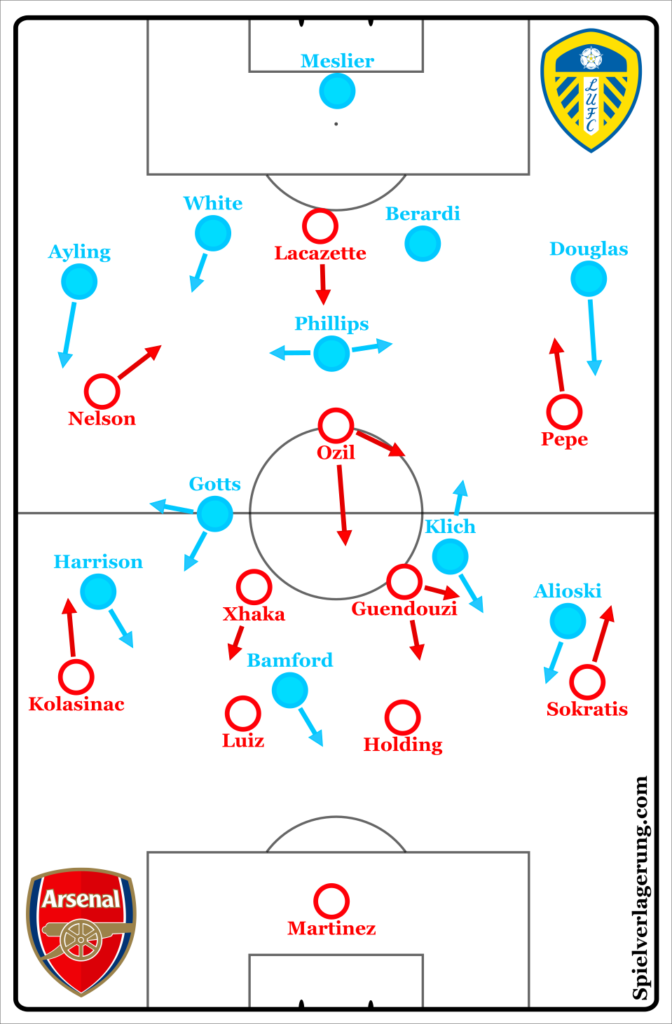
Bielsa’s side adopted their usual approach without the ball – looking to press their opponent through man-marking all over the field. Although this man-to-man approach leaves them susceptible to dismarking actions, it enables them to have good access to press given each players’ proximity to an opponent. Through this access, Leeds were able to apply and maintain pressure on Arsenal’s circulation and ultimately force them to play backwards. Thus, much of Arsenal’s possession in the first half was in their own third in build-up against Leeds’ high press.
The one player who Leeds didn’t look to press immediately was Rob Holding, and thus they forced Arsenal to build-up through the right centre-back. Patrick Bamford stayed close to David Luiz initially to stop the Brazilian from dictating the build-up with his far superior ability. As Leeds marked every nearby option, Holding had no easy way of progressing the ball and after he took one or two touches forwards, he would be pressed either by left-winger Alioski (while he closed the pass to right-back Sokratis), or Bamford (who would close of the pass to Luiz). If it was Bamford to shift across and press Holding, ball-far winger Jack Harrison would move slightly higher to be in a position to press Luiz if the ball was switched.
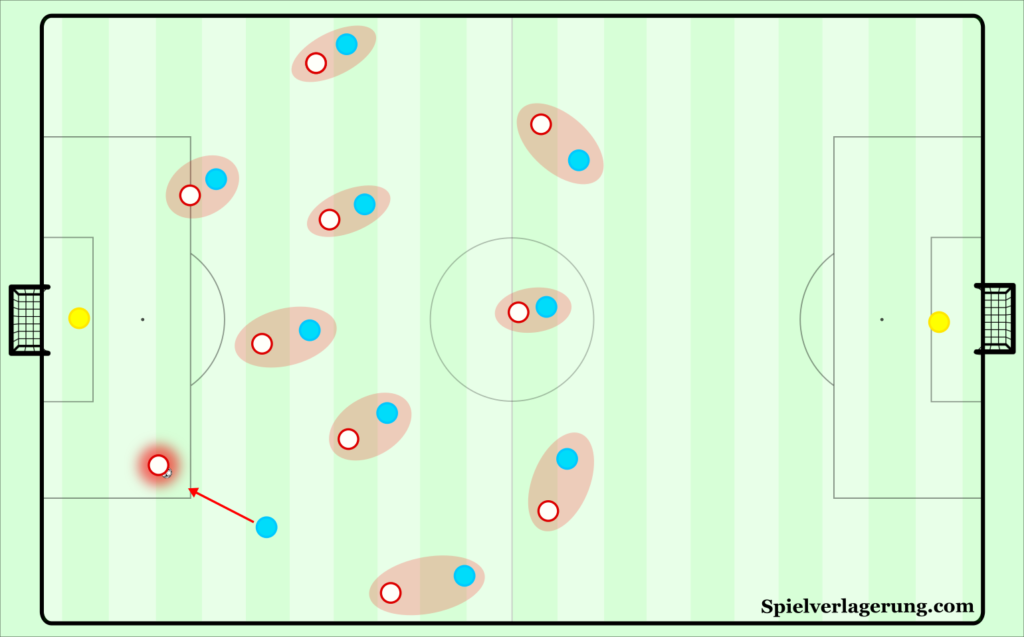
Particularly in the midfield three, Arsenal showed no clear plan of creating a free man against Leeds’ clear man-to-man press. Any movements to receive were made in a straight line – so that if they did receive, it would be flat into them with their back to goal and with immediate pressure from behind, reducing their options to play against the pressure. There were no positional rotations made between the three players while actions involving a third man were rare and seemingly unplanned. As a result of this lack of an idea, Arsenal clearly struggled to build-up with short passes against Leeds’ press.
Longer Alternative
Instead, Arteta’s side showed a slightly clearer plan with their alternative long build-up where, given Leeds’ defensive scheme, they looked to open the space in front of the opposition defensive line for Lacazette to receive more direct passes. However, despite having a clearer plan to create the initial space, their execution of the tactic thereafter was again lacking.
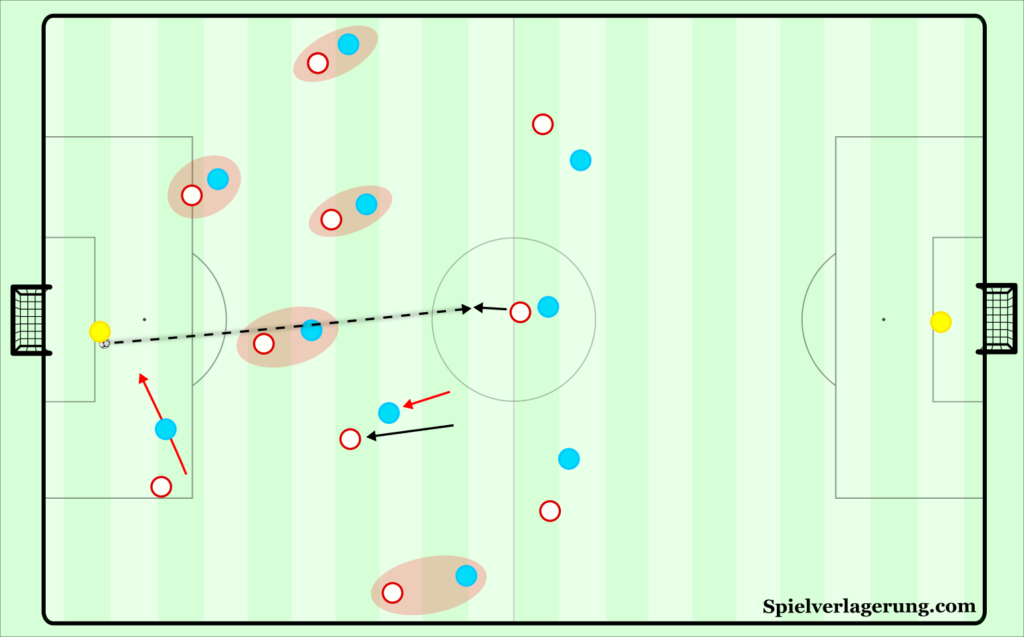
Firstly, the long passes into Lacazette from goalkeeper Martinez made it difficult for the Frenchman to receive. The passes were never flat enough, and with the ball taking longer in the air to reach its target, Leeds’ centre-backs were able to turn into a duel as the centre-forward received, often into his chest or as a header. It’s easy to compare this to the long distribution of Ederson, whose flat long passes enable Manchester City’s forward players to receive the ball to feet. The difficulty of receiving these passes for Lacazette meant that he rarely had the ball under enough control to then quickly find a teammate and continue the attack.
However therein lied Arsenal’s other issue. Regardless of Lacazette’s difficulty in receiving the ball initially, no teammate offered as a follow-up option for the striker to lay the ball off. With all three midfielders initially dropping, neither Guendouzi nor Özil would turn and move forwards quickly enough to then receive from Lacazette in front of their respective markers. In their front rather flat front three, the two wingers Nicolas Pépé and Reiss Nelson stayed rather wide during build-up. From these positions, neither could be in positions to feasibly receive from Lacazette.
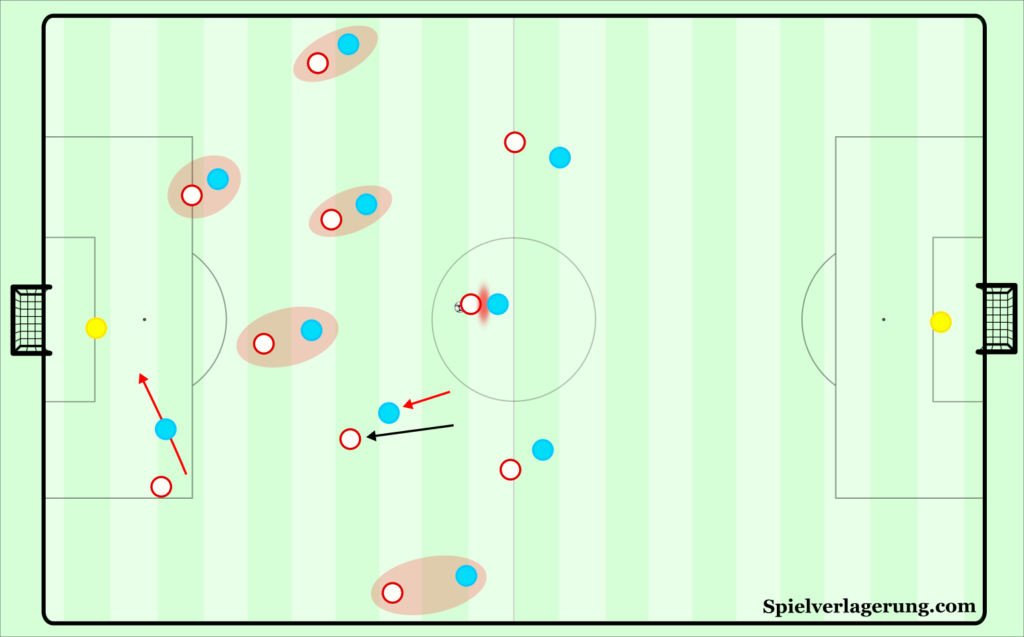
The need for consistent layoff options were even more important given that Lacazette was often receiving straight passes from Martinez. Receiving flat with his back to goal, he would easily be challenged by a centre-back. If he received the longer passes on more of an angle, then the former Lyonnais may have at least had a better opportunity to receive on the turn and move past his defender individually. However, due to Leeds’ effective press where Luiz’ influence was limited and much more responsibility thrust upon Rob Holding, Arsenal struggled to create situations where they could make these passes.
How Could Arsenal have Done it Better?
In such a situation, Arsenal’s wingers need to either:
a) Restrict Lacazette’s defender from pressing and allowing him to turn
b) Act as passing options so that the centre-forward can promptly lay-off the ball before the defensive pressure puts him at risk at losing it
Ultimately, Pépé and Reiss Nelson accomplished neither, but we can explore how they could have supported their teammate better.
Restrict the Defender
The most obvious way to restrict the defender from challenging Lacazette is to have threatening movement on his blind-side. With Reiss Nelson and Pépé’s pace, this would come in the form of diagonal runs in-behind from their wide positions (but would need to have a slightly narrower starting position than they had for most of the first half). Through these runs, the defender may be reluctant to leave as much space behind him with the danger that one of the wingers could be played free into it.
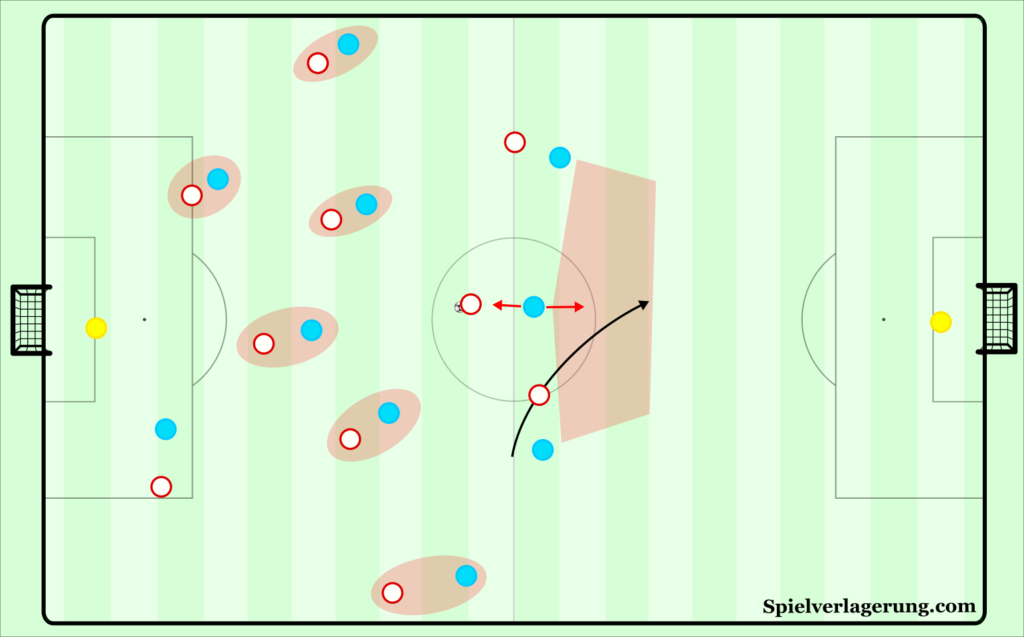
Another option may have been for both wingers to have a much narrower starting position, closer to the centre-backs than the full-backs so to pin the central players and stop them from stepping up. Then, Lacazette could drop deeper and have a better chance of receiving in space.
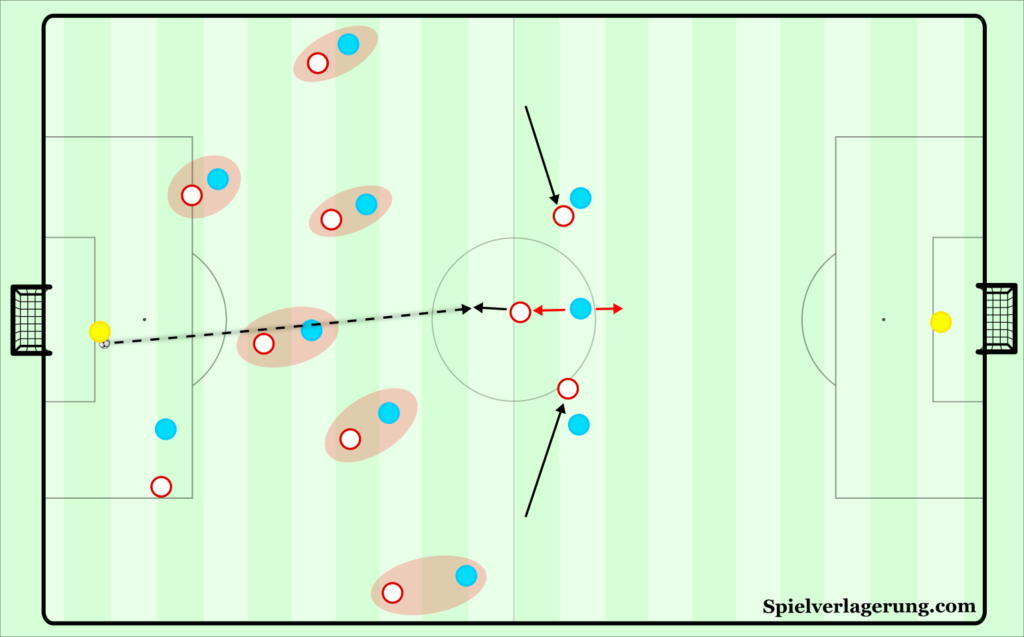
Now, this would likely be effective against most defenders. However, given the extremity of Leeds’ man-to-man approach, they could well have just continued by each defender following their man. Of course, this could have disorganised Leeds’ back line completely and created dangerous space, but Lacazette may still have been under too much pressure to find it.
Then, perhaps it’s more pertinent to look at the alternative, with players offering as ‘safer’ passing options in front of Lacazette so he can lay the ball off despite higher pressure from behind.
Act as Passing Options
Whereas movement to restrict the defender mainly involves attacking the space behind him, to act as a consistent passing option the players would likely have to move in front of Lacazette (though not as a necessity). Still, the two wingers would need to start from a slightly narrower position so that they are more connected to their centre-forward and can consistently be available to receive.
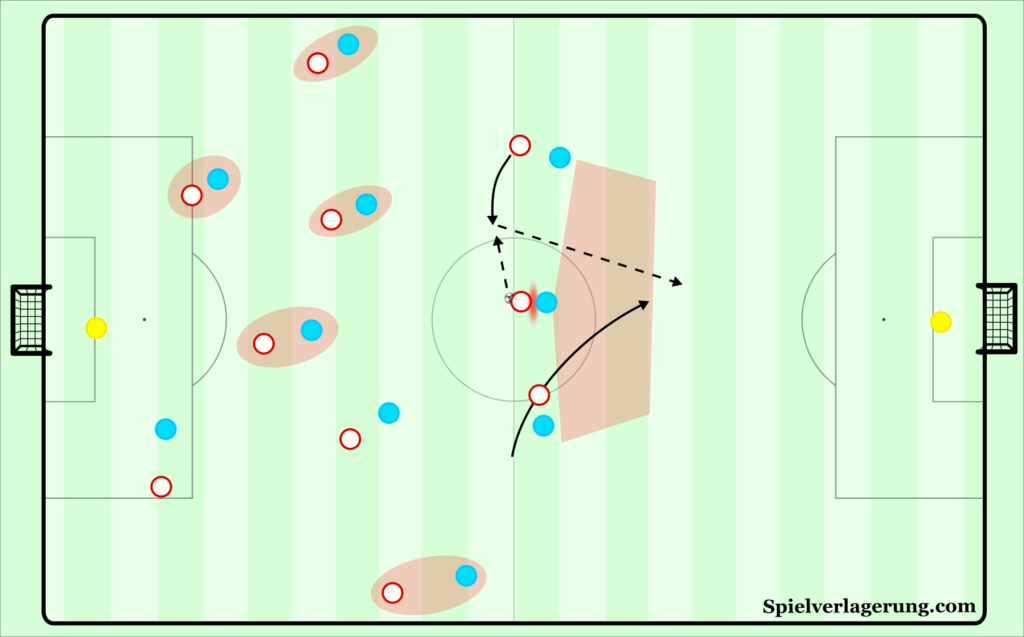
A big benefit of these movements of course is that they receive facing the opposition goal, allowing the attack to continue at speed. In such a situation, the ball-far winger then needs to act as a follow-up option and one which would otherwise create space for the winger to continue. This could then be a movement in-behind across defenders, or outside to receive to feet and create a one vs one.
Alternative Structure
As a more drastic alternative, Manchester City show another way of playing such situations against a man-to-man defence. To exploit a particular individual superiority over defenders, centre-forward moves far over to one side. This creates a split with two vs two on one flank and leaving a one vs one in as much space as possible. They can then look to get the ball to this one vs one to exploit the mis-match.
Alternative – Clip into Sokratis
The other direct option they used as an alternative was to play clipped passes onto Sokratis, who played as right-back. With Alioski approaching Holding inside, the Greek defender became a target for passes from Martinez and had a number of aerial duels against the physically-inferior Barry Douglas. This method wasn’t particularly effective either, as Pépé was quite poor in the second ball situations with Berardi defending him well.
Summary
The only true chance that Arsenal created from structured possession in the first half actually came from them losing the ball then immediately winning it back from counterpressure.
Within that lies one of the potential downsides of man-to-man pressing in that you’re more likely to win the ball back from duels as opposed to interceptions. The negative side of this is that you may be more susceptible to counterpressure upon winning the ball. If you win the ball in a duel – you immediately have an opponent in close proximity who can apply counterpressure.
For the most part, though, Leeds’ strategy stifled Arsenal significantly and restricted the home side from creating many dangerous situations at all. This is as much a testament to Leeds’ approach without the ball, which has steamrolled a number of Championship teams through its intensity, as it is a criticism of Arsenal’s lack of strategy to outplay it. When preparing for a team such as Leeds – who have a consistent approach regardless of opponent – you largely know what you’re in for. For this reason, it was quite surprising to see Arsenal without a clear strategy with the ball.
It must be said that it’s one thing to prepare a strategy, and it’s another to execute it on the pitch against such an intense opponent.
Leeds in Possession
Similarly to their opponents, Arteta’s side looked to direct Leeds to build through their weaker centre-back – Lacazette kept a starting position closer to right centre-back Ben White, leaving Gaetano Berardi on the ball. Their initial plan from here was for attacking midfielder Mesut Özil to step out towards the Italian centre-back from initially covering Leeds’ pivot Kalvin Phillips.
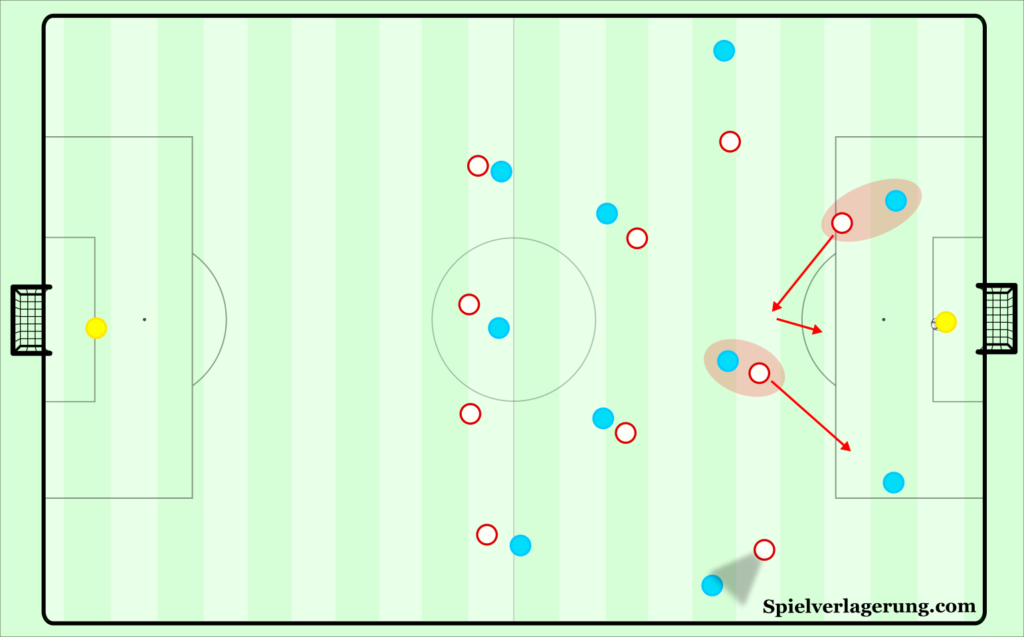
Finding Phillips
Immediately, there seemed to be miscommunication between Arsenal’s central attackers. Lacazette shifted over from his position on Leeds’ right centre-back and stayed in a position where he could press the goalkeeper upon a backpass. However, it seemed Özil was expecting his teammate to drop deeper and occupy Phillips as he stepped out to Berardi, as the German never checked his shoulder to adjust his movement so that he still screened the pass inside into the pivot. In his press, the German was also rather lethargic and didn’t approach the defender with any intensity (so to force him into a decision more quickly).
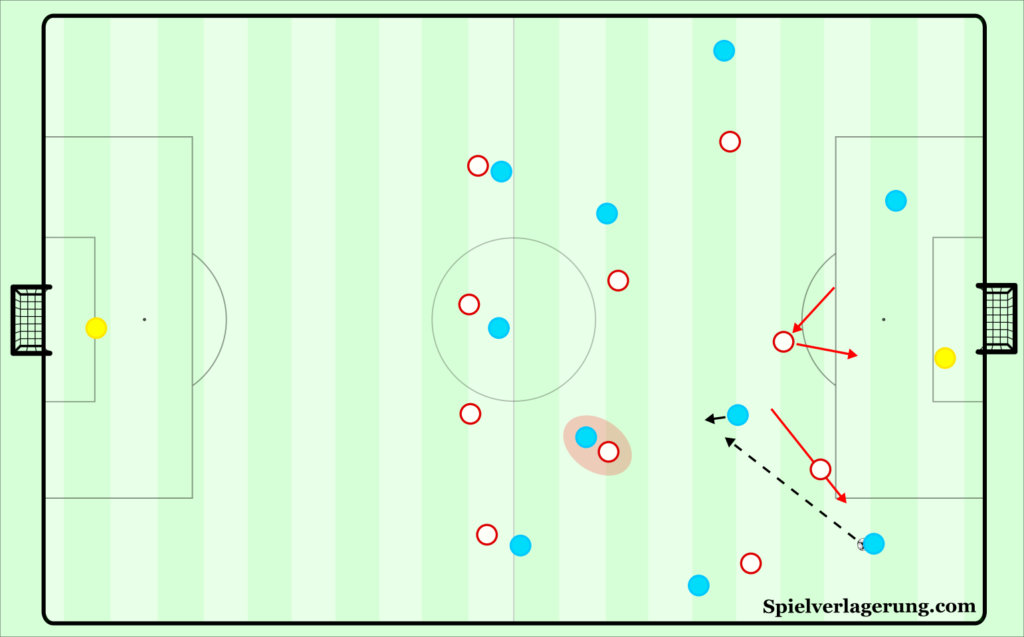
As a result, Leeds’ pivot was completely free to receive a diagonal pass inside from Berardi to break the press.
It was a similar story when Leeds managed to build-up from their right side too. In this case, Lacazette and Nelson were applying pressure with Özil deeper on Phillips. But Leeds’ homegrown midfielder found it very easy to move off of his opponents’ blind-side and sprint quickly to make himself available as a passing option inside – with the expectation that their teammate occupied Phillips, Arsenal’s pressers didn’t concern themselves with closing inside options and thus the route through the press was again clear.
Despite receiving in so much space, Phillips’ decision making was quite poor throughout the first half. Given that both of Leeds’ eights stayed higher, the pivot consistently had options to play vertically into the ball-near eight, or diagonally to the ball-far one. Both Gotts and Klich occupied good positions between Arsenal’s remaining midfielders, too.
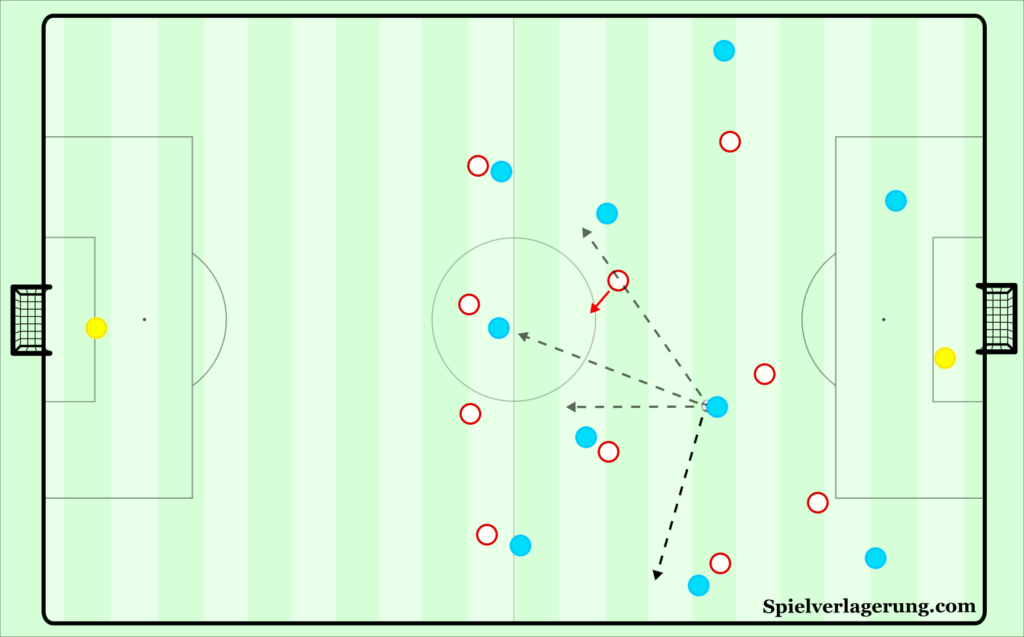
Instead, Phillips very quickly looked to play back outside to the full-back, despite having space in front of him to carry the ball. Eventually, after being instructed by one of Leeds’ many coaches, the pivot did find the ball-far eight with a diagonal pass to break the midfield line, but by that point he had missed a number of good opportunities to capitalise on their good build-up approach.
Leeds Outplay Arsenal with Simple Dismarking Movements around Pépé
Özil was a clear weak point of Arsenal’s press, but they had another in Nicolas Pépé. The Ivorian winger was frequently beaten by the most simple of dismarking movements which allowed Leeds to progress through their left. Their record signing showed very little awareness of players around him – rarely checking his blind-spots to inform his pressing actions. Consequently, Douglas could easily make himself free as a passing option after playing back to Berardi by moving inside as Pépé switched off as soon as the left-back played the ball backwards.
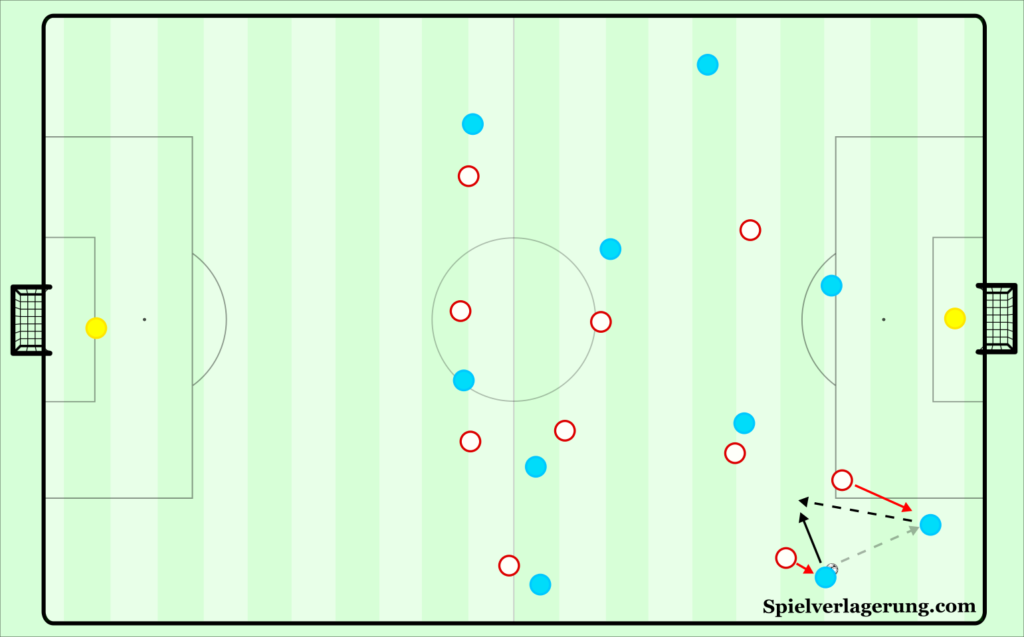
While I could go on about individuals’ failings in the high press, it’s a better opportunity to note how good Leeds are at these slight movements. It’s a very basic element of the game – to offer a different angle to receive after playing the ball to a teammate – but is one of many factors which has seen them dominate in a rather man-oriented Championship.
Particularly against a man-oriented press, these movements are crucial to give the receiver of the pass two options to play against his individual presser. In the case of Berardi against Pépé, the centre-back could easily play back to his left-back in space as the winger failed to track his man. If the defender does adjust to the movement then it typically opens up a space to dribble into for the player on the ball. These movements within combinations allow Bielsa’s side to consistently open up spaces inside the pitch to pass or dribble into.
Switches to Ayling
If Leeds couldn’t immediately play through down their left, they consistently looked for switches of play to their right-back Luke Ayling. The space itself was typically free when they had the ball on the left as the ball-far winger Reiss Nelson would step up to Ben White.
These switches were an effective way of diffusing Arsenal’s pressure or creating space to progress inside as the press shifted across. As Leeds’ eights maintained their positions fairly strictly during build-up, Gotts was consistently in a good position to receive inside from Ayling or in combination with winger Harrison. Alternatively, as Reiss Nelson would then backwards press Ayling, White could become free and Arsenal would have to drop deeper.
Arsenal better when…
Mikel Arteta clearly wasn’t content with his team’s efforts and encouraged Matteo Guendouzi to step up and defend closer to Mesut Özil. Doing so allowed Arsenal to have a more man-to-man approach in ball-near spaces and was a quick method of minimising the issues they had regarding Özil and Lacazette in covering Phillips.
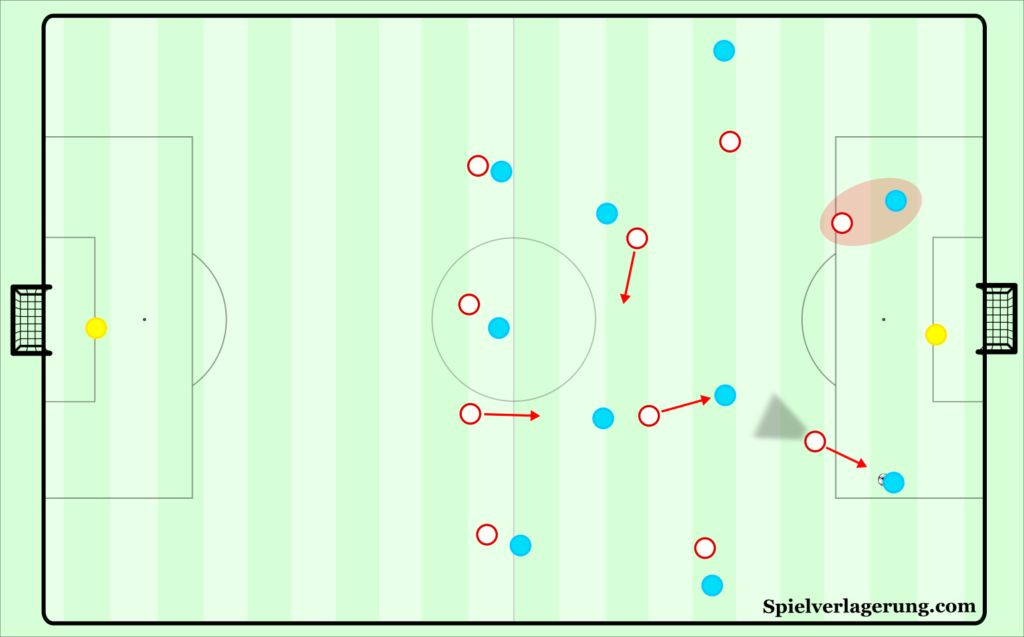
This of course meant that the home side had less cover in central midfield, but by being more able to stop Leeds’ initial progression in build-up, they fared better for the slight change overall.
Arsenal Improve Dramatically after Half-Time
While Leeds were dominant for the first 45 minutes, the dynamic of the second half was much different as Arteta’s side improved significantly.
Better in Build-up
Immediately you could see a change in their build-up as they sought to rectify some of their main issues in the first half. In their first possession under high pressure, David Luiz was able to play a long ground pass into Lacazette while being pressed by Bamford. As the centre-forward moved to receive, Reiss Nelson moved diagonally beyond him so that he could receive a flick-on into space behind Berardi who had stepped up.
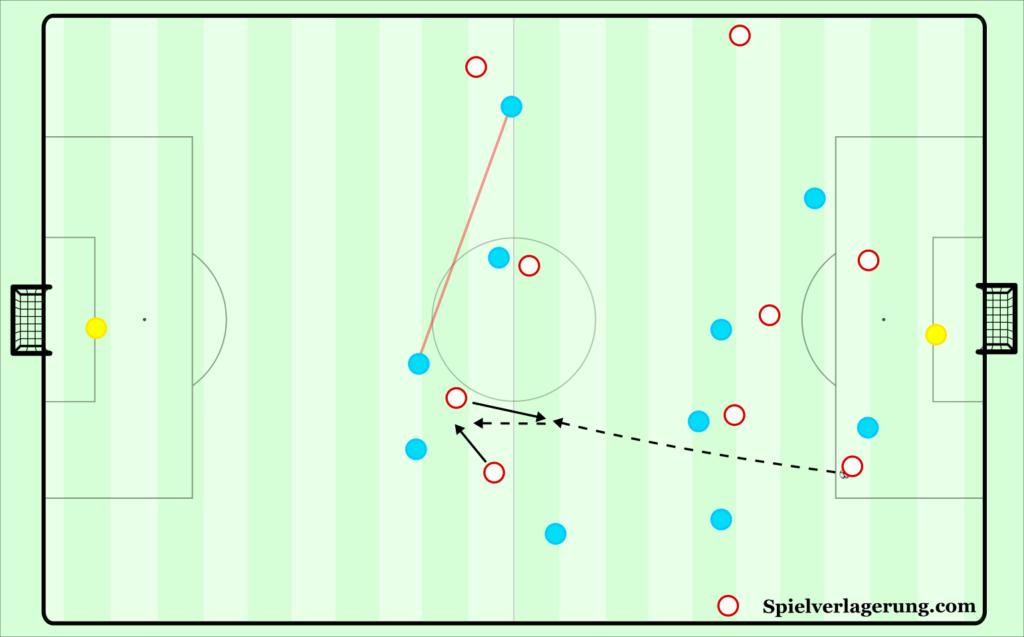
With regards to their issues in build-up previously, they found their striker with a flatter pass while the ball-near winger started closer and made a good supporting movement to receive immediately. On the ball-far side, Pépé maintained a wide position, likely to increase the space that Berardi would leave stepping up, and for Nelson to carry the ball into.
In the build-up to the only goal of the game, Holding carried the ball before finding Pépé between the lines. While the Ivorian struggled under pressure in the first half, he was able to dribble free of Douglas and drive into space created by Lacazette who moved diagonally beyond him. The winger ultimately was able to find the centre-forward after carrying the ball forwards, allowing him to assist the goal thanks to a fortuitous deflection.
Arsenal were also better structured in their short build-up, albeit to less clear success. Leeds continued to press similarly with Alioski pressing Holding inside, and so they consistently looked to find the free right-back via a bounce pass through Guendouzi. Initially, the pattern worked quite effectively with Guendouzi offering as a follow-up option inside by moving beyond his presser.
However, since this was Arsenal’s only real pattern to play short under pressure, Leeds began to anticipate these bounce passes quite well. Alioski would very quickly turn towards Sokratis as soon as Holding played the first pass, so the plan became less effective.
Better in High Press
Arsenal also fared better in their high press, although the reason for their improvement was initially less clear than in their build-up.
Structurally, Arsenal changed their approach from dead ball situations.
In the first half, where they initially allowed the first pass to Berardi before pressing, they instead looked to have more pressure on the first pass. This was done through Pépé having a higher starting position while Özil stayed on Phillips without the need to press in the first line. Of course, due to the goal-kick rule, they couldn’t literally prevent the first pass as was once possible, but the threat of Berardi being under immediate pressure made Leeds instead play more aerial clips out to their full-backs, who could be pressed by Guendouzi or the slightly deeper (since Lacazette still occupied White) Nelson.
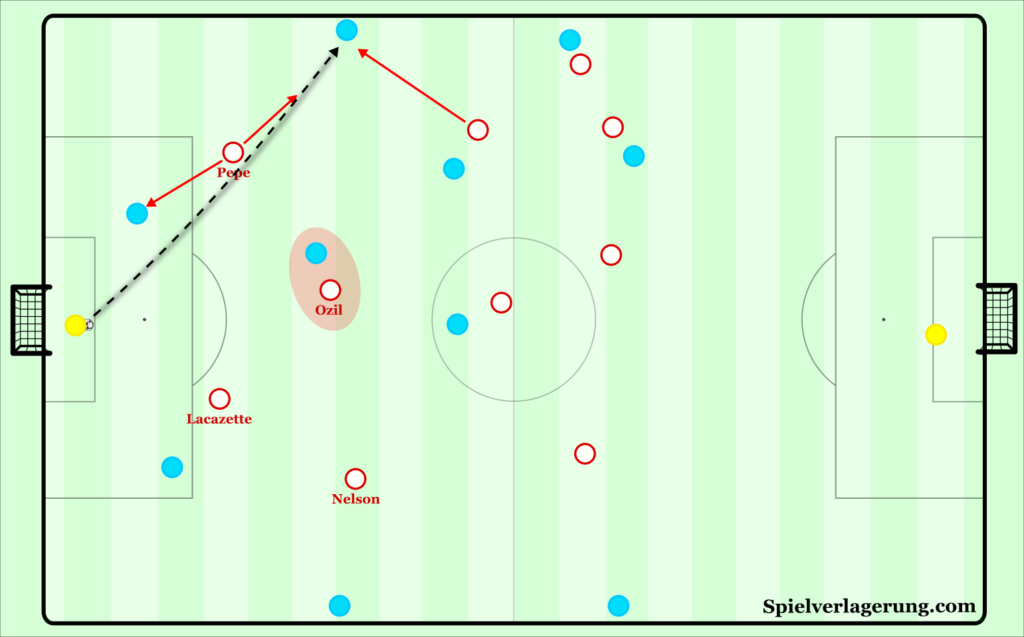
In open play situations, Arsenal didn’t make many significant changes to their strategy or tactics. Instead, probably the biggest change was the intensity of their approach, with the front players attacking the Leeds’ build-up at a much higher pace.
With the wingers acting higher and sometimes pressing the free centre-back, Özil was less required to move away from Phillips, which helped mask the flaw albeit situationally. If the six was free, then the simple higher pressure on the players in build-up made it more difficult for Leeds to find passes into the space. Guendouzi continued to perform well in his deeper role which saw him aggressively step-up to any free player if the pass was made through the press, in what was quite a good performance from the Frenchman out of possession.
A challenge which is often faced in analysis is deducing whether the opponent force a team to play worse, or the team plays worse by itself. Regarding Arsenal’s greater intensity without the ball, they certainly made Leeds perform worse from a technical perspective in the second half. But at the same time, Bielsa’s side misplaced a number of passes that they would otherwise have made in the first half, with a similar amount of defensive pressure applied. While Arsenal’s improvement explains their decline to an extent, I don’t think it can do so fully and I’m not quite sure why Leeds got worse in the second half. Fitness could have been a factor, as it was their fourth game in 10 days with little rotation for some positions.
Arsenal Become more Risk-Averse
After going ahead Arsenal became more risk-averse – particularly in their approach with the ball. The introduction of Martinelli about 10 minutes after the goal was an important factor, as they became very direct towards the left winger from build-up. The young forward had Ayling on toast, and repeatedly got the better of the defender who struggled to match Martinelli’s pace both in one vs ones and in combinations. Naturally, his dominance over Ayling made this direct approach more feasible for Arsenal.
Outside of Martinelli’s exploits, Arteta’s side managed the game quite well. They used fouls well (as a side point of their aggressive press) to stop Leeds from counter-attacking but also against their build-up to just break up the play. They time-wasted quite well when the ball went to the corners or out of play too. Arsenal did have some luck, with ricochets off of Leeds forwards leading to goal-kicks rather than corners, but largely did well of their own accord. The visitors had just one real chance in the last period of the game after beating the counterpressure brilliantly to create an opening from a second ball situation, but the opportunity was squandered.
Conclusion
Through Arteta’s changes at half-time, a much-improved Arsenal took the game away from Leeds after Bielsa’s side dominated the first half. Of course, the Gunners went onto win the tournament as they show promise under the Basque’s leadership despite some inconsistencies along the way.
Leeds went on a poor run following this loss with just one win in six, but then dropped just 4 points out of a remaining 42 to consolidate promotion. Bielsa’s side can be more than competitive in the Premier League, and I eagerly anticipate many interesting match-ups similarly to this one.


1 Kommentar Alle anzeigen
Thomas Booth September 9, 2020 um 9:53 am
I like how you provided solutions to the problems Arsenal faced rather than just analysing the match, great article